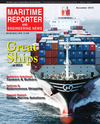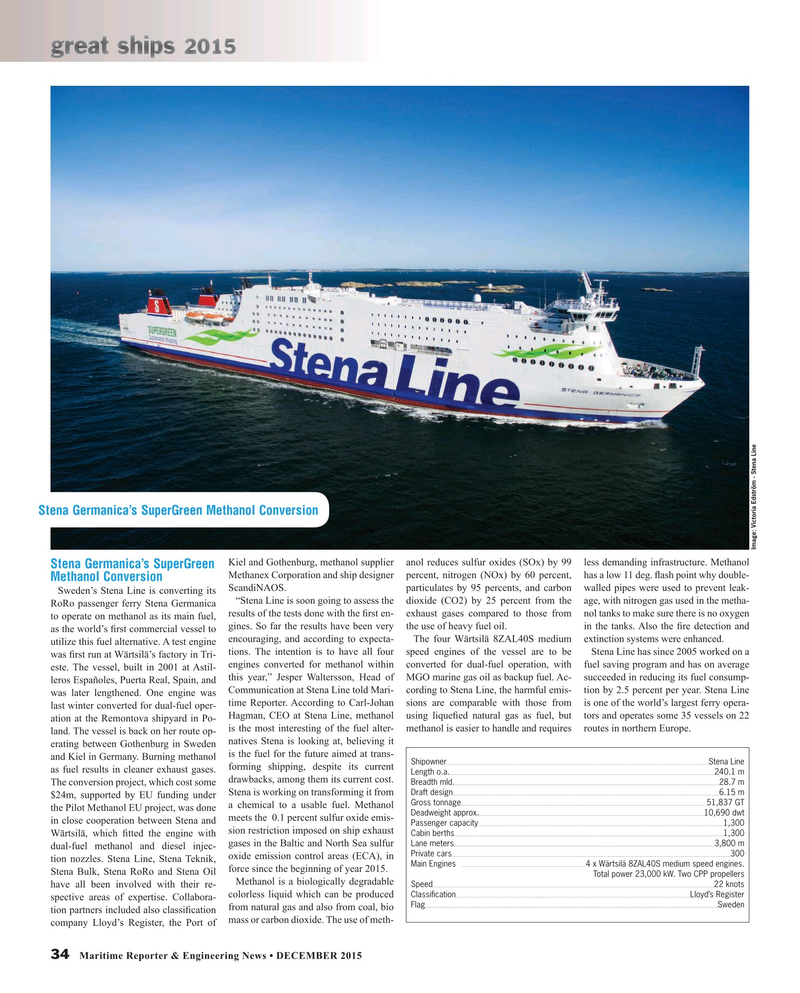
Page 34: of Maritime Reporter Magazine (December 2015)
Great Ships of 2015
Read this page in Pdf, Flash or Html5 edition of December 2015 Maritime Reporter Magazine
Stena Germanica’s SuperGreen Methanol Conversion
Image: Victoria Edström - Stena Line
Kiel and Gothenburg, methanol supplier anol reduces sulfur oxides (SOx) by 99 less demanding infrastructure. Methanol
Stena Germanica’s SuperGreen
Methanex Corporation and ship designer percent, nitrogen (NOx) by 60 percent, has a low 11 deg. ? ash point why double-
Methanol Conversion
Sweden’s Stena Line is converting its ScandiNAOS. particulates by 95 percents, and carbon walled pipes were used to prevent leak- “Stena Line is soon going to assess the dioxide (CO2) by 25 percent from the age, with nitrogen gas used in the metha-
RoRo passenger ferry Stena Germanica to operate on methanol as its main fuel, results of the tests done with the ? rst en- exhaust gases compared to those from nol tanks to make sure there is no oxygen as the world’s ? rst commercial vessel to gines. So far the results have been very the use of heavy fuel oil. in the tanks. Also the ? re detection and utilize this fuel alternative. A test engine encouraging, and according to expecta- The four Wärtsilä 8ZAL40S medium extinction systems were enhanced. tions. The intention is to have all four speed engines of the vessel are to be Stena Line has since 2005 worked on a was ? rst run at Wärtsilä’s factory in Tri- engines converted for methanol within converted for dual-fuel operation, with fuel saving program and has on average este. The vessel, built in 2001 at Astil- leros Españoles, Puerta Real, Spain, and this year,” Jesper Waltersson, Head of MGO marine gas oil as backup fuel. Ac- succeeded in reducing its fuel consump- was later lengthened. One engine was Communication at Stena Line told Mari- cording to Stena Line, the harmful emis- tion by 2.5 percent per year. Stena Line time Reporter. According to Carl-Johan sions are comparable with those from is one of the world’s largest ferry opera- last winter converted for dual-fuel oper-
Hagman, CEO at Stena Line, methanol using lique? ed natural gas as fuel, but tors and operates some 35 vessels on 22 ation at the Remontova shipyard in Po- is the most interesting of the fuel alter- methanol is easier to handle and requires routes in northern Europe.
land. The vessel is back on her route op- erating between Gothenburg in Sweden natives Stena is looking at, believing it and Kiel in Germany. Burning methanol is the fuel for the future aimed at trans-
Shipowner Stena Line as fuel results in cleaner exhaust gases. forming shipping, despite its current
Length o.a. 240.1 m drawbacks, among them its current cost.
Breadth mld. 28.7 m
The conversion project, which cost some
Draft design 6.15 m $24m, supported by EU funding under Stena is working on transforming it from
Gross tonnage 51,837 GT a chemical to a usable fuel. Methanol the Pilot Methanol EU project, was done
Deadweight approx. 10,690 dwt in close cooperation between Stena and meets the 0.1 percent sulfur oxide emis-
Passenger capacity 1,300
Cabin berths 1,300
Wärtsilä, which ? tted the engine with sion restriction imposed on ship exhaust
Lane meters 3,800 m gases in the Baltic and North Sea sulfur dual-fuel methanol and diesel injec-
Private cars 300 tion nozzles. Stena Line, Stena Teknik, oxide emission control areas (ECA), in
Main Engines 4 x Wärtsilä 8ZAL40S medium speed engines.
Stena Bulk, Stena RoRo and Stena Oil force since the beginning of year 2015. Total power 23,000 kW. Two CPP propellers
Methanol is a biologically degradable
Speed 22 knots have all been involved with their re-
Classi? cation Lloyd’s Register colorless liquid which can be produced spective areas of expertise. Collabora-
Flag Sweden tion partners included also classi? cation from natural gas and also from coal, bio company Lloyd’s Register, the Port of mass or carbon dioxide. The use of meth- 34 Maritime Reporter & Engineering News • DECEMBER 2015
MR #12 (34-40).indd 34 12/4/2015 12:37:29 PM

 33
33

 35
35
